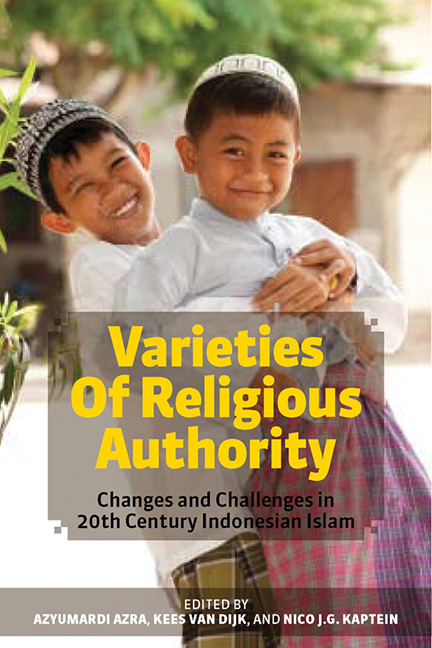Book contents
- Frontmatter
- Contents
- About the Contributors
- Acknowledgements
- Introduction
- 1 The Redefinition of Religious Authority among South Asian Muslims from 1919 to 1956
- 2 Understanding Al-Imam's Critique of Tariqa Sufism
- 3 Traditional Islam and Modernity: Some Notes on the Changing Role of the Ulama in Early Twentieth Indonesia
- 4 The Role and Identity of Religious Authorities in the Nation State: Egypt, Indonesia, and South Africa Compared
- 5 Authority Contested: Mathla'ul Anwar in the Last Years of the New Order
- 6 Struggle for Authority: Between Formal Religious Institution and Informal-local Leaders
- 7 The Indonesian Madrasah: Islamic Reform and Modernization of Indonesian Islam in the Twentieth Century
- 8 From Apolitical Quietism to Jihadist Activism: “Salafis”, Political Mobilization, and Drama of Jihad in Indonesia
- 9 From handling Water in a Glass to Coping with an Ocean: Shifts in Religious Authority in Indonesia
- 10 Religious Authority and the Supernatural
- Index
2 - Understanding Al-Imam's Critique of Tariqa Sufism
Published online by Cambridge University Press: 21 October 2015
- Frontmatter
- Contents
- About the Contributors
- Acknowledgements
- Introduction
- 1 The Redefinition of Religious Authority among South Asian Muslims from 1919 to 1956
- 2 Understanding Al-Imam's Critique of Tariqa Sufism
- 3 Traditional Islam and Modernity: Some Notes on the Changing Role of the Ulama in Early Twentieth Indonesia
- 4 The Role and Identity of Religious Authorities in the Nation State: Egypt, Indonesia, and South Africa Compared
- 5 Authority Contested: Mathla'ul Anwar in the Last Years of the New Order
- 6 Struggle for Authority: Between Formal Religious Institution and Informal-local Leaders
- 7 The Indonesian Madrasah: Islamic Reform and Modernization of Indonesian Islam in the Twentieth Century
- 8 From Apolitical Quietism to Jihadist Activism: “Salafis”, Political Mobilization, and Drama of Jihad in Indonesia
- 9 From handling Water in a Glass to Coping with an Ocean: Shifts in Religious Authority in Indonesia
- 10 Religious Authority and the Supernatural
- Index
Summary
The dissemination of Islam in Indonesia in the twentieth century has been a process inextricably bound up with the active engagement of Southeast Asians with their emerging national communities. As Benedict Anderson has argued, such communities were increasingly “imagined” from the nineteenth century through the crucial engine of “print capitalism”, both regionally and in the world at large, and in ways that superseded older faith-based identities (Anderson 1991). For the Indonesian case though, I have argued that this process of imagining was more complicated, and that it drew upon, and was reinforced by, the communal experiences of Muslim pilgrims as they crossed the well-worn paths of their home isles or were carried by steamers across the sea-lanes of the Indian Ocean (Laffan 2003).
Over time, many such sojourners would return to their home ports or hinterland communities with thoughts about their faith, their place in the world, and how the practice of the former might impact on the rank of the latter. Certainly the debates that were set in motion — most often concerning modernity, independence and reform — suffused the growing public sphere. Indeed they had their after-effects well into the end of the twentieth century, although the present state of doctrinal alignments — between “modernists”, “traditionalists” and (more recently) “Salafists”, tends to obscure the instabilities and shifting nature of the positions taken by their forerunners.
In this chapter I therefore wish to revisit an early stage in the process of “modern” religious change in Southeast Asia by a close textual analysis of passages in the seminal Malay journal al-Imam (The Leader). I shall do so mainly in order to ascertain the extent to which its programme aligned with that imputed to the Cairo-based Muslim reformers Muhammad ʿAbduh (1849–1905) and Rashid Rida (1865–1935). More specifically, I will examine the arguments that were voiced in respect of the acceptable role of Sufism in the modern world.
- Type
- Chapter
- Information
- Varieties of Religious AuthorityChanges and Challenges in 20th Century Indonesian Islam, pp. 17 - 53Publisher: ISEAS–Yusof Ishak InstitutePrint publication year: 2010



